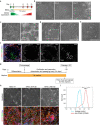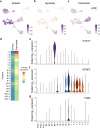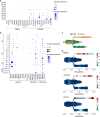Human archetypal pluripotent stem cells differentiate into trophoblast stem cells via endogenous BMP5/7 induction without transitioning through naive state
- PMID: 38332235
- PMCID: PMC10853519
- DOI: 10.1038/s41598-024-53381-w
Human archetypal pluripotent stem cells differentiate into trophoblast stem cells via endogenous BMP5/7 induction without transitioning through naive state
Abstract
Primary human trophoblast stem cells (TSCs) and TSCs derived from human pluripotent stem cells (hPSCs) can potentially model placental processes in vitro. Yet, the pluripotent states and factors involved in the differentiation of hPSCs to TSCs remain poorly understood. In this study, we demonstrate that the primed pluripotent state can generate TSCs by activating pathways such as Epidermal Growth Factor (EGF) and Wingless-related integration site (WNT), and by suppressing tumor growth factor beta (TGFβ), histone deacetylases (HDAC), and Rho-associated protein kinase (ROCK) signaling pathways, all without the addition of exogenous Bone morphogenetic protein 4 (BMP4)-a condition we refer to as the TS condition. We characterized this process using temporal single-cell RNA sequencing to compare TS conditions with differentiation protocols involving BMP4 activation alone or BMP4 activation in conjunction with WNT inhibition. The TS condition consistently produced a stable, proliferative cell type that closely mimics first-trimester placental cytotrophoblasts, marked by the activation of endogenous retroviral genes and the absence of amnion expression. This was observed across multiple cell lines, including various primed induced pluripotent stem cell (iPSC) and embryonic stem cell (ESC) lines. Primed-derived TSCs can proliferate for over 30 passages and further specify into multinucleated syncytiotrophoblasts and extravillous trophoblast cells. Our research establishes that the differentiation of primed hPSCs to TSC under TS conditions triggers the induction of TMSB4X, BMP5/7, GATA3, and TFAP2A without progressing through a naive state. These findings propose that the primed hPSC state is part of a continuum of potency with the capacity to differentiate into TSCs through multiple routes.
© 2024. The Author(s).
Conflict of interest statement
The authors declare no competing interests.
Figures






Similar articles
-
Derivation of functional trophoblast stem cells from primed human pluripotent stem cells.Stem Cell Reports. 2022 Jun 14;17(6):1303-1317. doi: 10.1016/j.stemcr.2022.04.013. Epub 2022 May 19. Stem Cell Reports. 2022. PMID: 35594858 Free PMC article.
-
Current Strategies of Modeling Human Trophoblast Using Human Pluripotent Stem Cells in vitro.Curr Protoc. 2023 Oct;3(10):e875. doi: 10.1002/cpz1.875. Curr Protoc. 2023. PMID: 37787612 Free PMC article.
-
Human primed and naïve PSCs are both able to differentiate into trophoblast stem cells.Stem Cell Reports. 2022 Nov 8;17(11):2484-2500. doi: 10.1016/j.stemcr.2022.09.008. Epub 2022 Oct 20. Stem Cell Reports. 2022. PMID: 36270280 Free PMC article.
-
The role of BMP4 signaling in trophoblast emergence from pluripotency.Cell Mol Life Sci. 2022 Jul 25;79(8):447. doi: 10.1007/s00018-022-04478-w. Cell Mol Life Sci. 2022. PMID: 35877048 Free PMC article. Review.
-
Induction of human trophoblast stem cells.Nat Protoc. 2022 Dec;17(12):2760-2783. doi: 10.1038/s41596-022-00744-0. Epub 2022 Oct 14. Nat Protoc. 2022. PMID: 36241723 Review.
Cited by
-
Transient chemical-mediated epigenetic modulation confers unrestricted lineage potential on human primed pluripotent stem cells.Sci China Life Sci. 2025 Apr;68(4):1084-1101. doi: 10.1007/s11427-024-2660-3. Epub 2025 Jan 13. Sci China Life Sci. 2025. PMID: 39825205
-
A transcriptomic comparison of in vitro models of the human placenta.Placenta. 2025 Jan;159:52-61. doi: 10.1016/j.placenta.2024.11.007. Epub 2024 Nov 26. Placenta. 2025. PMID: 39637677 Free PMC article.
-
Generation of Bona Fide Human Induced Trophoblast Stem Cells by Direct Reprogramming of Term Umbilical Cord Cells.Int J Mol Sci. 2024 Dec 31;26(1):271. doi: 10.3390/ijms26010271. Int J Mol Sci. 2024. PMID: 39796127 Free PMC article.
References
MeSH terms
Substances
Grants and funding
LinkOut - more resources
Full Text Sources

